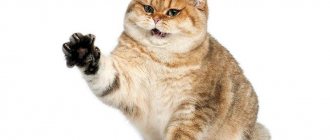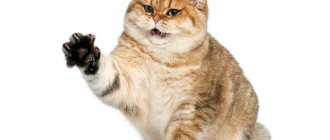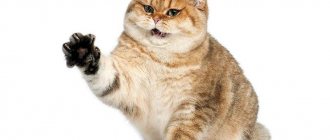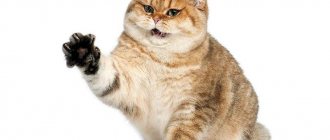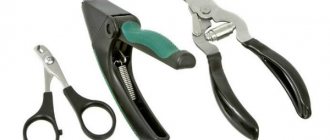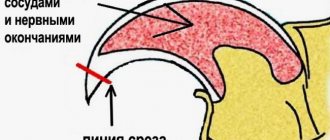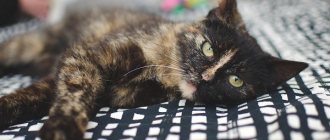For many domestic cats, nail trimming is a must. Growing nails cause discomfort to animals, and if they are not shortened in time, inflammation may begin. However, you need to properly prepare for a cat “manicure” and learn the technique of performing it. Then the procedure will take place with minimal stress and will not cause pain to the cat.
Which animals are not recommended for the procedure?
There is no need to trim the claws of a cat that roams freely outside. She needs her nails to climb trees, hunt and defend herself from other four-legged animals.
Also, the procedure is not performed on kittens under 1 month of age. Their claws are not yet formed. Early cutting negatively affects the structure of the nail plate and leads to delamination.
But already at 2 months the claws are strongly extended, and the kitten begins to scratch. At this time they can already be cut.
Do all cats need to have their nails trimmed?
You should get a manicure if your cat is an indoor cat and does not go outside. When your pet walks in the fresh air or visits a dacha, you cannot cut its nails. A free-range animal wears down the tips of its claws while climbing trees or running on asphalt. Cats need them for defense against enemies; without them the animal is defenseless. Veterinarians do not encourage this procedure, especially if the pet is healthy. However, in some situations you need to do this:
- When an animal behaves aggressively, it is very dangerous for small children.
- Scratches walls, furniture, doors in the apartment.
- Clings to floor coverings and soft blankets, risking injury.
Under no circumstances should you trim the claws of a pregnant cat, as this can cause premature birth. If a small kitten has settled in the house, it is advisable to accustom it to the procedure from an early age. The baby hisses and bites - then you should postpone the lesson and repeat it later. The need for nail trimming may depend on the breed, for example, Sphynxes and Persians sometimes have specific problems.
In Persian cats, keratinized growths often grow and peel off. This occurs due to a deficiency of vitamins B and D in the body. Hair mats (mats) also form between the fingers, which need to be cut. The Scottish Fold breed often suffers from claw abnormalities, which needs to be carefully monitored and trimmed in a timely manner. If you don’t do this, your pet may get caught and pull out the claw completely. Also, during play, a cat can injure a person or other animal.
Nothing can replace the love of their owner for our pets. They trust us with their health and life. Let's make the stay of furry pets near us safe and calm. After all, our life becomes much more interesting with cats.
What tools can you use?
There are special nail clippers for trimming cat claws. It is not recommended to use nail scissors. They are designed for thin and flat nail plates of people. Such cutting tools lead to delamination.
There are several types of nail clippers:
- Blisters - resemble nail scissors, but have blades curved at the ends, designed for cat claws.
- Secateurs are equipped with a spring, which is located between the handles. As a rule, such models have a limiter. It allows you to cut only the desired length.
- Guillotines are similar to cigar scissors. The nail is placed in the hole at the end. When the handles are closed, the blade lowers and cuts the claw. The tool is suitable for cats with thick nail plates.
Each owner chooses the model that is convenient for him to use. The main thing is that it is made of high-quality materials and sharpened.
Additionally, you can buy an electric trimmer that allows you to quickly trim your nails. However, not all cats react calmly to it - the buzzing device scares the animals.
Important. When cutting, the blade of the guillotine nail clipper must move from bottom to top, otherwise the risk of crushing the nail increases. This is especially dangerous for kittens whose claw plates are not yet strong enough.
How to trim a cat's claws
To trim your cat's claws yourself, you should visit a pet store or veterinary pharmacy. There is a wide range of special tools available. These are ultra-modern devices and run on batteries or mains power.
Regular scissors.
Every home has a tool; it is allowed for trimming soft nails of young animals. The main condition is extreme caution so as not to cut off the excess part of the claw and not touch a blood vessel.
Claw clippers.
There is no need to experiment with ordinary nail clippers; here you need: a special pruner, reinforced nippers, nail clippers.
Guillotine trimmer.
A good device for removing the tips of thick, strong nails. Makes the cut as rounded as possible. The only drawback is the noise, which scares the cat.
Grinder.
The device is convenient and easy to use. The working element is a sharpening stone with an abrasive coating, which allows you to grind the surface painlessly. Polishing takes place gradually.
File.
It is better to purchase a tool with round ends; it will be needed to remove irregularities after working with nail clippers.
The devices must be well sharpened; it is recommended to give preference to stainless steel tools. The handles are made of non-slip material so as not to accidentally injure the animal.
How often is nail trimming done?
The frequency of haircuts depends on the individual characteristics of the cat. For some, it is enough to carry out the procedure once a month, for others – every 2-3 weeks.
As a rule, light-colored nails grow faster. And in cats that prefer active games, partial wear occurs naturally. To determine the exact timing, you just need to carefully observe your pet.
For your information. A cat needs to have its claws trimmed before an exhibition, competition or other important event.
How much does it cost to trim nails at the vet?
Nail trimming in a veterinary clinic is a guarantee of a high-quality and safe procedure. Doctors use professional nail clippers with particularly sharp sharpening. A grooming salon can also help with this manipulation.
The average price of a haircut in Russia is about 300 rubles. In some small clinics, claws can be trimmed for 50 rubles, and in large centers the cost of cutting claws reaches 350-500 rubles.
If the pet is aggressive, and the owner cannot restrain it himself, ensuring the safety of the doctor, additional restraint may be required, which is paid for in most veterinary institutions.
Preparing for the first procedure
To trim a cat's claws with minimal stress, the animal is first accustomed to this procedure. It is better to start doing this in childhood. Kittens adapt to any changes more easily than adults.
For your information. There are cases where adult cats, accustomed to clinging with their claws while jumping, have fallen and been injured due to the fact that their nails were suddenly cut.
Preparations for grooming begin at a time when the cat is not doing anything (not playing, licking itself, eating or sleeping). They take her in their arms and stroke her affectionately.
Then they carefully move to the paws - they try to touch, lightly massage, imitate a haircut. At the same time, they talk to the pet and try to switch its attention to something interesting so that it does not break out.
As a rule, kittens do not like to have their paws touched, so the first 2-3 times they will get irritated and run away. But if you regularly repeat this exercise, the baby will get used to the manipulations. To reinforce the positive associations, he is given a treat at the end.
When the kitten begins to be calm about being touched, they begin to “rehearse” the haircut itself:
- put the pet in the desired position;
- take each paw in turn;
- examine the nails, press on the pads.
If the kitten tolerates all the actions, he is sincerely praised.
Then the pet is introduced to the nail clipper. It is important to show that the tool does not pose any danger. After the animal begins to treat him calmly, you can cut the kitten’s claws for real.
Is there an alternative: “soft paws” and “anti-scratch pads”
In fact, there is only one alternative and how humane it is is the question. We are talking about an operation to remove claws - onychectomy. The need for it may arise in case of severe claw disease, traumatic damage to the fingers, or excessive aggressiveness of the animal. But in recent years, some animal owners are doing this without medical indications, but only to prevent their animals from damaging their furniture.
The glamorous name “soft paws” actually hides the amputation of the last claw phalanx on the animal’s toes. The operation is performed under general anesthesia, which in itself is a serious test for the animal’s body. Removal of claws can lead to a number of diseases and affect the psyche and behavior of an animal deprived of an innate tool, but not the need to use it.
A more humane method to prevent damage to hands and furniture is silicone claws or “anti-scratches.” These are silicone caps that are glued to the claw with special glue. They produce several sizes for cats of different ages and breeds, and all kinds of colors. Multi-colored caps not only allow you to be creative in choosing a manicure, but also make it easier to find and clean up fallen nails. The latter is especially true for families with small children and other animals who may pick up and eat something from the floor.
The gluing procedure is in many ways similar to trimming nails and is no less stressful for the animal. It should be taken into account that silicone pads change the animal’s tactile sensations when walking, playing, and affect jumping and the ability to climb objects.
Experts have differing opinions regarding silicone claws. On the one hand, there is no particular harm from them, and in comparison with “soft paws” they are completely harmless. But, on the other hand, for the animal it is stress and suppression of instincts.
Perhaps reviews from more experienced cat owners will help you decide on the need for the procedure. But remember that “anti-scratches” do not solve the problem at the root. It is still necessary to trim your cat's claws, as they continue to grow under the silicone.
Step-by-step instruction
A cat's claws consist of a keratinized layer, inside of which there is a pulp - a collection of nerve endings and blood vessels. When trimming, it is important not to touch a sensitive area, otherwise it will be very painful for your pet and blood will come from the wound.
In cats with light-colored claws, the pulp is clearly visible - it looks like a pink, crescent-shaped area. You can point your paw at a bright light or use a flashlight - the picture will be clearer.
It is more difficult to trim the claws of cats with dark pigmentation - you will have to act blindly. In this case, carefully cut off 1-2 mm at a time until the color inside becomes a little lighter - this is the beginning of the pulp.
For your information. Before cutting, remove the hair between the pads so that it does not interfere.
Nail trimming begins when the cat is calm, relaxed and ready to communicate. At this point, the owner should disinfect his hands and nail clippers, prepare cotton pads and antiseptic in case of injury.
Step-by-step instructions for trimming nails at home:
- The owner takes a comfortable position, puts the cat on his lap with his back to himself or lays him on his back. Particularly mobile pets can be wrapped in a terry towel.
- He takes the paw in his hand and presses on the pad to expose the claw.
- He brings the nail clipper to his paw. If the cat does not show concern, clicks it. In case of anxiety, he strokes and calms the pet, after which he repeats the manipulation.
- Now quickly and confidently sets the nail cutter 1-2 mm to the pulp and trims the claw so that the edge remains sharp. If you cut the platinum at the wrong angle, you will be more likely to hit the pulp.
- At the end, the cuts are rounded off with a nail file, giving a natural shape. In the future, you will be able to trim your claws less frequently if you regularly trim the overgrown areas.
If you trim your cat's nails correctly, your cat will not experience any discomfort. In fact, many animals struggle and hiss not because of pain, but because they are scared.
In order not to overwork the cat, the haircut is carried out in several passes. For example, one paw is treated daily.
Claws as a natural means of attack, defense and a tool for practical use
The ancestors of cats were nocturnal, living in savannas and semi-deserts, spending part of their time in trees. Small, but very tenacious and strong claws in the shape of Turkish scimitars helped them deftly and quickly climb branches, escaping from larger predators, serving as means of defense and helping to retain prey.
Today, domestic cats remain essentially the same small, dangerous predators. Pets need claws for normal movement, as they serve as a kind of stoppers that prevent sliding, and also help to climb various surfaces.
Cats have 5 toes on their front paws, and 4 on their hind paws, plus one vestigial one. There are 18 claws in total and they are constantly growing. To get rid of the old part of the horny tissue and keep the “equipment” constantly sharp, cats need to sharpen their claws. It is for this purpose that the “scratching post” is used. It should be large enough so that the animal, stretching out to its full height, can sharpen its claws heartily.
If you do not take care of purchasing such a device and do not train your pet to use it, you should not be surprised that it will begin to damage furniture, carpets, wooden trim, door frames, and so on. If you provide the animal with the necessary “tools”, it will not cause mischief. So there is no need to get rid of the natural tool of attack and defense.
If you do not provide the cat with the necessary accessories, events can go according to two scenarios:
- A well-mannered, good-natured creature will not harm the owner’s property, but will suffer itself. Very long claws, without constant grinding, grow strongly, bend and can dig into the pad or into the skin fold between the fingers. This can cause serious inflammation and suppuration. In severe cases, the infection penetrates the bone, “melting” it, and the cat may lose a finger. Such a defect will negatively affect its gait, agility and ability to hunt. In the wild, the injured animal would not have survived.
- If necessary, cats deftly give themselves a “manicure” by biting off the offending part of the claw. But it still needs to be ground off, because sharp debris can injure the cat itself or the pets. In the absence of a “claw”, its role will be played by completely inappropriate and unintended objects. Owners should not be surprised or indignant if a cat tears a chair, the upholstery of an expensive leather sofa, or scratches the legs of valuable wooden furniture.
If no amount of effort can be used to wean the animal from encroaching on the property of its owners, and the cat stubbornly ignores all tools, practicing only on Persian carpets, you will have to resort to a last resort - trimming its claws. This is an important and responsible operation, and you need to be able to do it correctly.
What to do if the animal is not given
To trim the claws of cats that categorically refuse this procedure, they use fixing overalls. They provide access to all limbs, but do not allow the pet to move freely.
At first, it is advisable to carry out the haircut with an assistant who will hold the animal. If the cat meows loudly and struggles, take a break. Let her rest and calm down for a while, then you can try again.
Important. You should not swear or shout at a cat if it resists while trimming its claws. Aggression from the owner will only frighten her. In the future, the pet will try by all means to avoid the unpleasant procedure.
When trimming my cat's claws, my cat began to bleed, how can I stop it?
Any cosmetic procedure for an animal requires maximum attention and accuracy.
- Nail trimming is a traumatic procedure. The risk of injuring your pet is quite high.
- The reason for this may be a poor-quality tool, too large a cutting angle, touching the blood vessels in the claw, or simply your pet was scared of something and twitched.
- Similar cases can occur both in an experienced owner and in a novice.
If such a situation occurs, do not panic. Inspect the site of injury if possible. If the wound is shallow, treat it with hydrogen peroxide and bandage it, calm the animal. If you see that the bleeding does not stop, after pre-treatment, apply a bandage to the sore spot and, as soon as possible, contact a specialized clinic. The veterinarian will carry out all the necessary procedures and advise how to prevent a recurrence of the incident.
The main thing is not to panic
The structure of the claw of the mustache
In their structure, cat claws are close to human nails. They consist of 2 layers:
- epidermis, which performs a protective function;
- pulp containing nerve fibers and choroid plexuses.
Unlike the epidermis on the body, the nail includes a much larger amount of keratin.
It is this that protects the pulp, which is easy to detect by its pinkish tint. INTERESTING!
The most dangerous form of claws is curved, like those of Persian cats. Thanks to it, animals can inflict very deep and painful wounds.
Possible difficulties
Having figured out how to trim a cat’s claws, all that remains is to evaluate the possible difficulties. These include categorical refusal of the procedure by the “mustache” and the appearance of blood from an accidental cut.
Refusal to get a haircut
At first, refusal is absolutely normal. Before developing a habit, you can use an assistant who will hold and calm the obstinate animal while you are busy. If you do not have the time and desire to fight the mustache, then use the services of a groomer or veterinarian.
Another alternative option is special “anti-scratch” pads. They are small silicone caps, but are mainly needed solely to protect furniture - and they last no more than 1 month. If your pet strictly uses a scratching post and does not encroach on forbidden interior items, then this device will be useless.
Appearance of blood
The most important thing in such a situation is not to panic, because you should have a first aid kit prepared in advance. Apply an antiseptic to a cotton pad and carefully treat the injured area, not forgetting to calm the mustachioed victim.
ADVICE!
If your pet does not stop bleeding for a long time, apply a cold compress to the wound and purchase a special hemostatic powder for the future. It will speed up the regeneration process.
Remember that experience does not come immediately. At first, small mistakes and difficulties are quite acceptable. Over time, you will definitely learn how to do a cat manicure no worse than a professional groomer.
Do you like the article? 0
Why do you need to cut your hair?
Let's figure out whether this is painful, whether it leads to bad consequences? After all, many novice cat breeders always have such doubts. Let's consider two opposite cases.
Article continues after advertisement
In the first, the cat is a street cat or often goes outside on her own. Then she really needs claws for protection and hunting. If your cat is half street, then it is better not to cut her claws, or cut them a little if they have already grown very long. But usually this is not required, because by climbing trees, actively running and catching mice, she wears down her claws very well - and they will not grow to excessive length.
Additionally, if you trim the claws of a cat that has access to the outdoors, you are exposing her to harm. If other cats or dogs chase her, she will be able to fight back with sharp weapons. If the claws are trimmed, she will be an easy target. Such a case was recorded by volunteers from Crimea. They stole a cat from the dogs, whose unlucky owners trimmed its claws and let it out for a walk. As a result, the dogs attacked him badly, and only the incredible efforts of veterinarians helped him survive.
In the second case, the cat is completely domestic. She does not need sharp claws to climb a tree and defend herself. And since her lifestyle is less mobile, her claws are less likely to wear down, resulting in them becoming longer than necessary. As a result, the cat will cling to everything with them even when it doesn’t want to, that is, they will simply get in the way. And, of course, they will annoy the owners. In this case, a haircut is necessary. And if the cat is old, then the fifth claws, which are usually hardly sharpened, can generally grow to such an extent that they curl and dig into the skin.
In addition, according to the advice of veterinarians, if the cat’s character is too greyhound, then trimming its claws will also bring down its arrogance a little, because With sharp claws, the animal feels more confident as a predator. However, after proper claw trimming, the cat will retain all of its ability to catch, grab and cling to objects with its paw and even climb vertical surfaces, so it will not become helpless in any case. He just won’t want to climb onto the curtain again, and even if he does, he won’t leave such terrible marks on the material. Well, scratching, bathing and playing with her will be a pleasure for you, because trimmed claws practically do not leave scratches on the skin.
